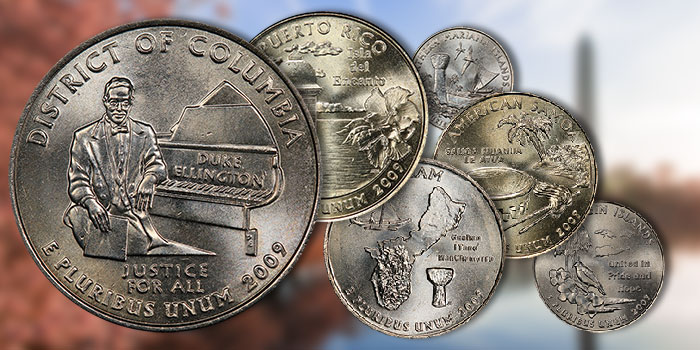
By Joshua McMorrow-Hernandez for PCGS ……
The 50 State Quarters program was one of the most successful and ambitious United States Mint coin design programs of the last five decades. When it was launched in 1999, the Statehood Quarters initiative captured the imagination of an entire nation, making evening news headlines as each new quarter was launched beginning with the nation’s first state of Delaware and concluding with the 50th state of Hawaii in 2008.
The 50 State Quarters inspired nearly 150 million Americans to collect coins and even became a cultural phenomenon. The 50 State Quarters program was originally authorized by legislation – and long publicized – as an educational homage to the 50 states. Even capped at “just” 50 coins over 10 years, it was a monumental program of unprecedented complexity and duration.
However, a provision in the 1997 Act that authorized the 50 State Quarters program permitted the addition of Washington, D.C. and/or any of the nation’s territories if they, too, became states prior to 2009. But none did, much to the disappointment of several lawmakers on Capitol Hill who wanted to see the District of Columbia and the nation’s outlying territories honored on their own Statehood Quarters.
Early on during the 50 State Quarters program, motions were made to pass a bill that would extend the program by one more year to commemorate the District of Columbia, Puerto Rico, the Northern Mariana Islands, Guam, the U.S. Virgin Islands, and America Samoa on their own special quarters. None of these efforts made much headway beyond the House of Representatives until 2007, when a bill finally passed the Senate and was signed by President George W. Bush.
Those who supported the addition of six coins to the 50 State Quarters series claimed it would reinvigorate interest in the original series while garnering huge revenues on their own merits. Meanwhile, the numismatic world was abuzz as it began repackaging products aimed for the 50 State Quarters with revisions that accommodated the six new coins. The one-year series, which dropped in early 2009 as the District of Columbia and United States Territories Quarters, was indeed a hit with collectors. The six new quarters also spawned a few noteworthy storylines.
Taxation Without Representation
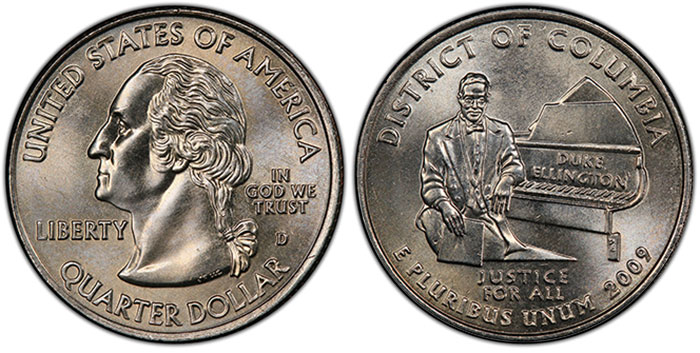
Among the more colorful narratives were the controversies stemming from the early designs for the District of Columbia Quarter.
Originally, proposals for the DC Quarter called for the inclusion of the motto “Taxation Without Representation”, a political slogan dating back to the 1700s and originally used to decry the British policy of taxing the 13 American colonies despite their not having colonial representation in the British Parliament. In more recent years, the phrase has been appropriated by residents of the District of Columbia to criticize the current situation in which those living in Washington, D.C., proper are subject to paying federal taxes but have no formal representation in the halls of Congress.
“Taxation Without Representation” is a common rally call among those who reside within or have interests in Washington, D.C. Even the district’s standard-issue license plates carry the phrase along the bottom of the automobile tags. However, officials with the United States Mint were concerned the phrase was too controversial to be placed on a coin and thus shunned designs incorporating its usage.
The design that ultimately was carried out on the 2009 District of Columbia Quarter honors Washington, D.C., native Duke Ellington, who wrote more than 3,000 songs and helped establish the District’s popular U Street corridor, where jazz clubs, theaters, and restaurants have delivered an eclectic brand of entertainment for generations. The coin, designed by Joel Iskowitz and engraved by Don Everhart, carries the inscription “JUSTICE FOR ALL” – arguably less divisive a slogan than the one originally pitched for the District of Columbia Quarter. Meanwhile, Ellington became the first black American to be prominently featured on a regularly circulating United States coin.
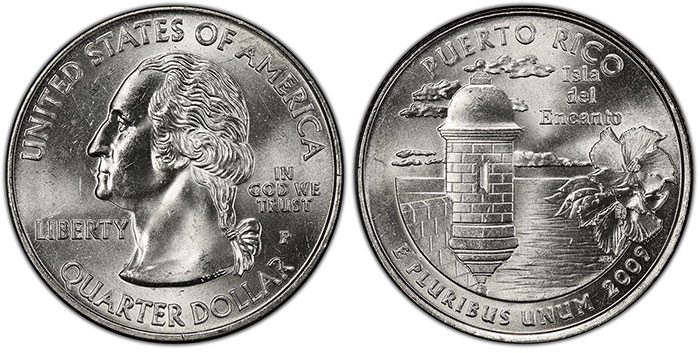
Islas del Encanto
Another historic first among the 2009 District of Columbia and U.S. Territories Quarters can be found on the 2009 Puerto Rico Quarter, designed by Joseph F. Menna.
This coin is emblazoned with the phrase “ISLA DEL ENCANTO”, which translates to English as “ISLAND OF ENCHANTMENT”. This phrase became the first Spanish inscription ever seen on a federally produced, circulating United States coin. Other elements on the Puerto Rico Quarter include a sentry turret and a visage of the Atlantic Ocean as viewed from Old San Juan and a Maga tree flower, which is seen throughout the island and serves as the national symbol of Puerto Rico.
Akin to the Puerto Rico Quarter, the other four quarters released in 2009 primarily feature natural and cultural symbology.
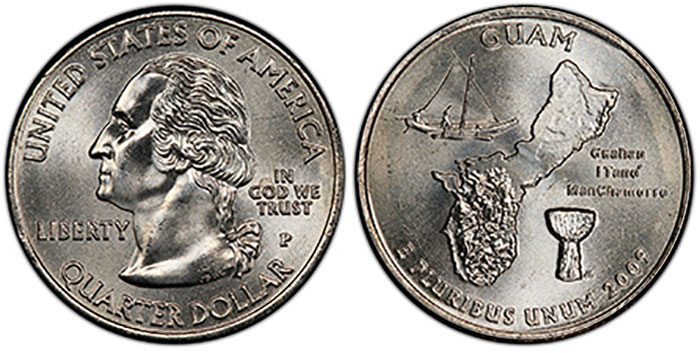
The Guam Quarter, designed by David Westwood and engraved by Jim Licaretz, features a geographical outline of the Western Pacific island, a proa boat, and a hemispherical stone piece known as a latte; the phrase “Guahan I Tano ManChamorro”, meaning “Guam, land of the Chamorro”, is seen on the coin and refers to the name of the indigenous people who have resided on the land known as Guam and nearby islands for millennia.
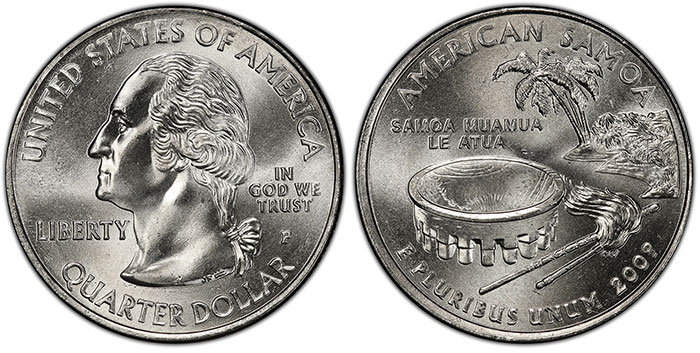
Released next was the American Samoa Quarter, designed by Stephen Clark and engraved by Charles L. Vickers. The reverse design is anchored by the visage of an ava bowl, which is traditionally used to contain ceremonial beverages during important occasions. Also seen on the coin are a whisk and staff, with a coconut tree and the Pacific shoreline in the background. The coin’s prominent reverse inscription, “SAMOA MUAMUA LE ATUA”, means “SAMOA, GOD IS FIRST”.

The U.S. Virgin Islands Quarter showcases geographical outlines of the three major islands that constitute the bulk of this Caribbean territory. The left side of the reverse, by Joseph Menna, is graced by a species of bird known as a bananaquit, flanked by a yellow cedar and a tyre palm. The design is accompanied by the inscription “United in Pride and Hope”.
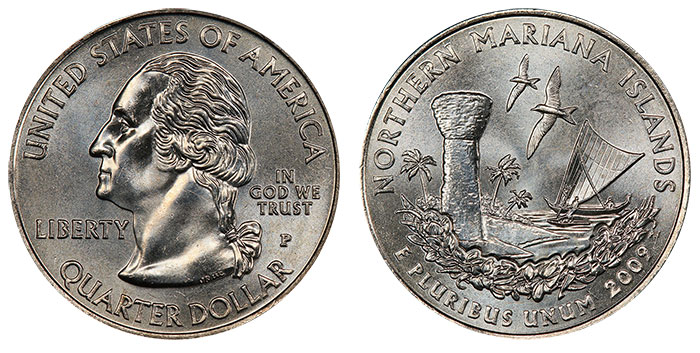
The sixth and final issue of the District of Columbia and United States Territory Quarter series is a coin designed by Richard Masters and engraved by Phebe Hemphill that honors the Northern Mariana Islands. Similar to the stone relic seen on the Guam Quarter, a large latte anchors the reverse, a canoe made by the indigenous Carolinian peoples is seen near the shoreline in the background. Flying from right to left across the top of the design are two white fairy tern birds, while the bottom of the design is cradled within a mwar head lei.
Collecting the D.C. and U.S. Territory Quarters
The 2009 Quarters aren’t necessarily rare or valuable in the absolute sense, but there are some challenges to be had by collectors who are looking for top-notch business strikes, errors, and varieties. Notably, all of the copper-nickel clad circulation strikes in grades of MS67 are tough, while examples grading higher are considerably rarer and trade for hundreds, even thousands of dollars.
A plethora of garden-variety errors and minor doubled dies have been spotted across the 2009 Quarters, though perhaps the most significant such error is a prominent doubled die found on 2009-D District of Columbia Quarters. This doubled die shows significant doubling in the “ELL” spelling Duke Ellington’s name as well as doubling in the piano keys and the front panel of the piano. This diagonal doubling shows the superfluous design elements southeast of their respective primary design. PCGS recognizes this variety as the 2009 District of Columbia Quarter DDR FS-801, a rarity boasting around a dozen PCGS-graded examples. The coin trades for around $3,000 in MS66 and has a single PCGS-graded MS67 representing the finest grade known for the variety.
* * *






I have a coin that has Duke Ellington on the back and 2 presidents on the front. It was in a roll of quarters I bought from the bank